
Schnure, senior vice president for research and economic analysis, downplays concerns about a major economic slowdown, and makes the case that solid fundamentals will provide the impetus for the economy and the real estate market to keep growing.
He sees a likely slowing of GDP growth, but not a sharp letup given healthy business activity and consumer demand that can handle moderately higher interest rates. He puts the odds of slowing to less than 2.5% at 20%, slight easing to between 2.5% and 3% at 60% and accelerating above 3% at 20%.
He notes, however, that energy prices and trade wars are wildcards.
Inflation, according to Schnure, is likely to rise only between 1.7% and 2.2% by the end of 2019, which would be in line with the Federal Reserve's target.
He says there is a seven in 10 chance that the Fed will limit itself to just one more rate increase in 2019, likely in the first half of the year. This will result in a federal funds rate of 2.75% or less by year-end.
Schnure sees a 50% chance that long-term interest rates will end the year at between 3.25% and 3.75%. "Even with modest increases, these financing rates are still low and are favorable for real estate," he says.
"The next year is likely to be a good but not great one for real estate, with solid job growth, consumer spending and business activity driving demand for nearly all types of commercial real estate."




